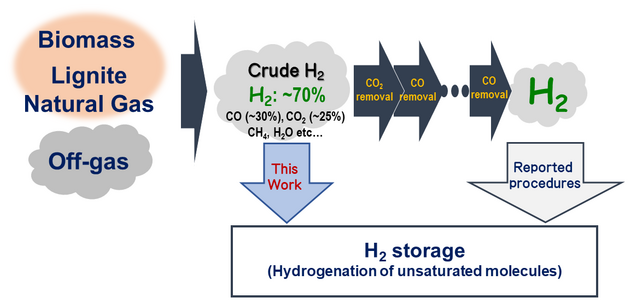Reviewed by Mila PereraOct 27 2022
Hydrogen is essential to the modern economy, and the expansion of its utility to promote a more sustainable society is a global priority.
 The concept of this work. Direct use of crude hydrogen gas for catalytic hydrogenation of unsaturated molecules. Image Credit: Y. Hoshimot
The concept of this work. Direct use of crude hydrogen gas for catalytic hydrogenation of unsaturated molecules. Image Credit: Y. Hoshimot
In a recent study in the Science Advances journal, scientists from Osaka University have made stimulating progress toward removing several of the bottlenecks in utilizing hydrogen as an energy carrier.
As a chemical precursor to ammonia, which is utilized in fertilizer production, hydrogen has aided in feeding the world. In the future, hydrogen may continue to save lives by acting as a fuel. A significant hindrance to this aim is how hydrogen is currently produced.
There are several methods available for producing hydrogen, such as reacting high-temperature steam with natural gas, but such methods lead to the production of crude hydrogen, consisting of contaminant gases that are challenging to eliminate, reducing the value of the resulting hydrogen.
For the commercial use of hydrogen, all contaminants should be strictly eliminated by adopting multistep, energy-intensive processes that are individually optimized for every contaminant. Therefore, the process makes it hard to remove the hydrogen from the crude mixture consisting of the by-products.
The trouble of extracting hydrogen from common contaminant gases has limited the utility of liquid organic hydrogen carriers, the state-of-the-art for hydrogen storage. In such systems, several scientists have battled for decades to beat the difficulty of inducing the carriers to uptake, i.e., to store, hydrogen in the existence of contaminant gases.
For example, “even a small amount of carbon monoxide can hinder hydrogen uptake,” says Yoichi Hoshimoto, the corresponding author. “Thus, costly purification methods to isolate the hydrogen prior to storage are necessary.”
For these difficulties to be overcome, Hoshimoto and his research group have synthesized shelf-stable triaryl boranes that occupy hydrogen even in the presence of common contaminant gases. This creation helps achieve the subsequent innovative outcomes: hydrogen storage (with up to >99% efficiency) and subsequent hydrogen release at a purity of up to 99.9%.
The industrial value of molecular hydrogen has long been plagued by substantial quantities of carbon monoxide and other contaminants. However, in the catalytic hydrogenation method we developed, even a five-fold excess of a contaminant wasn’t a problem, and hydrogen uptake and release were each achieved without using any solvents.
Yoichi Hoshimoto, Study Corresponding Author, Osaka University
This work has succeeded in a proof-of-concept for a novel hydrogen production method that helps remove the requirement for isolated purification stages before storage, and it hence illustrated the ability to increase the economic sustainability of hydrogen as an energy carrier.
Future advances in increasing the environmental sustainability of hydrogen production, for instance, by obtaining it from water, will additionally help to bring a tenable hydrogen-based economy.
Journal Reference
Hashimoto, T., et al. (2022) Main group catalysis for H2 purification based on liquid organic. hydrogen carriers. Science Advances. doi.org/10.1126/sciadv.ade0189.